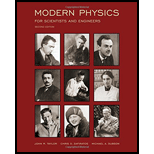
Modern Physics For Scientists And Engineers
2nd Edition
ISBN: 9781938787751
Author: Taylor, John R. (john Robert), Zafiratos, Chris D., Dubson, Michael Andrew
Publisher: University Science Books,
expand_more
expand_more
format_list_bulleted
Concept explainers
Question
Chapter 2, Problem 2.39P
To determine
To Prove:
cosθB=β, where β is the dimensionless velocity of A .
Expert Solution & Answer
Want to see the full answer?
Check out a sample textbook solution
Students have asked these similar questions
Solve and answer correctly please.Thank you!!
A cart on wheels (assume frictionless) with a mass of 20 kg is pulled rightward with a 50N force. What is its acceleration?
Two-point charges of 5.00 µC and -3.00 µC are placed 0.250 m apart.a) What is the electric force on each charge? Include strength and direction and a sketch.b) What would be the magnitude of the force if both charges are positive? How about the direction?
c) What will happen to the electric force on each piece of charge if they are moved twice as far apart? (Give a numerical answer as well as an explanation.)
Chapter 2 Solutions
Modern Physics For Scientists And Engineers
Ch. 2 - Prob. 2.1PCh. 2 - Prob. 2.2PCh. 2 - Prob. 2.3PCh. 2 - Prob. 2.4PCh. 2 - Prob. 2.5PCh. 2 - Prob. 2.6PCh. 2 - Prob. 2.7PCh. 2 - Prob. 2.8PCh. 2 - Prob. 2.9PCh. 2 - Prob. 2.10P
Ch. 2 - Prob. 2.11PCh. 2 - Prob. 2.12PCh. 2 - Prob. 2.13PCh. 2 - Prob. 2.14PCh. 2 - Prob. 2.15PCh. 2 - Prob. 2.16PCh. 2 - Prob. 2.17PCh. 2 - Prob. 2.18PCh. 2 - Prob. 2.19PCh. 2 - Prob. 2.20PCh. 2 - Prob. 2.21PCh. 2 - Prob. 2.22PCh. 2 - Prob. 2.23PCh. 2 - Prob. 2.24PCh. 2 - Prob. 2.25PCh. 2 - Prob. 2.26PCh. 2 - Prob. 2.27PCh. 2 - Prob. 2.28PCh. 2 - Prob. 2.29PCh. 2 - Prob. 2.30PCh. 2 - Prob. 2.31PCh. 2 - Prob. 2.32PCh. 2 - Prob. 2.33PCh. 2 - Prob. 2.34PCh. 2 - Prob. 2.35PCh. 2 - Prob. 2.36PCh. 2 - Prob. 2.37PCh. 2 - Prob. 2.38PCh. 2 - Prob. 2.39PCh. 2 - Prob. 2.40PCh. 2 - Prob. 2.41PCh. 2 - Prob. 2.42PCh. 2 - Prob. 2.43PCh. 2 - Prob. 2.44PCh. 2 - Prob. 2.45PCh. 2 - Prob. 2.46PCh. 2 - Prob. 2.47PCh. 2 - Prob. 2.48PCh. 2 - Prob. 2.49PCh. 2 - Prob. 2.50PCh. 2 - Prob. 2.51PCh. 2 - Prob. 2.52P
Knowledge Booster
Learn more about
Need a deep-dive on the concept behind this application? Look no further. Learn more about this topic, physics and related others by exploring similar questions and additional content below.Similar questions
- y[m] The figure shows two snapshots of a single wave on a string. The wave is traveling to the right in the +x direction. The solid line is a snapshot of the wave at time t=0 s, while the dashed line is a snapshot of the wave at t=0.48s. 0 0.75 1.5 2.25 3 8 8 6 6 4 2 4 2 0 -2 -2 -4 -4 -6 -6 -8 -8 0 0.75 1.5 2.25 3 x[m] Determine the period of the wave in units of seconds. Enter your numerical answer below including at least 3 significant figures. Do not enter a fraction, do not use scientific notation.arrow_forwardNo chatgpt pls will upvotearrow_forwardAn extremely long, solid nonconducting cylinder has a radius Ro. The charge density within the cylinder is a function of the distance R from the axis, given by PE (R) = po(R/Ro)², po > 0.arrow_forward
- An extremely long, solid nonconducting cylinder has a radius Ro. The charge density within the cylinder is a function of the distance R from the axis, given by PE (R) = po(R/Ro)², po > 0.arrow_forwardA sky diver of mass 90 kg (with suit and gear) is falling at terminal speed. What is the upward force of air drag, and how do you know?arrow_forwardA car is traveling at top speed on the Bonneville salt flats while attempting a land speed record. The tires exert 25 kN of force in the backward direction on the ground. Why backwards? How large are the forces resisting the forward motion of the car, and why?arrow_forward
- Please help by: Use a free body diagram Show the equations State your assumptions Show your steps Box your final answer Thanks!arrow_forwardPlease help by: Use a free body diagram Show the equations State your assumptions Show your steps Box your final answer Thanks!arrow_forwardBy please don't use Chatgpt will upvote and give handwritten solutionarrow_forward
arrow_back_ios
SEE MORE QUESTIONS
arrow_forward_ios
Recommended textbooks for you
 University Physics Volume 3PhysicsISBN:9781938168185Author:William Moebs, Jeff SannyPublisher:OpenStax
University Physics Volume 3PhysicsISBN:9781938168185Author:William Moebs, Jeff SannyPublisher:OpenStax Classical Dynamics of Particles and SystemsPhysicsISBN:9780534408961Author:Stephen T. Thornton, Jerry B. MarionPublisher:Cengage Learning
Classical Dynamics of Particles and SystemsPhysicsISBN:9780534408961Author:Stephen T. Thornton, Jerry B. MarionPublisher:Cengage Learning Modern PhysicsPhysicsISBN:9781111794378Author:Raymond A. Serway, Clement J. Moses, Curt A. MoyerPublisher:Cengage Learning
Modern PhysicsPhysicsISBN:9781111794378Author:Raymond A. Serway, Clement J. Moses, Curt A. MoyerPublisher:Cengage Learning Physics for Scientists and Engineers: Foundations...PhysicsISBN:9781133939146Author:Katz, Debora M.Publisher:Cengage Learning
Physics for Scientists and Engineers: Foundations...PhysicsISBN:9781133939146Author:Katz, Debora M.Publisher:Cengage Learning Principles of Physics: A Calculus-Based TextPhysicsISBN:9781133104261Author:Raymond A. Serway, John W. JewettPublisher:Cengage Learning
Principles of Physics: A Calculus-Based TextPhysicsISBN:9781133104261Author:Raymond A. Serway, John W. JewettPublisher:Cengage Learning Glencoe Physics: Principles and Problems, Student...PhysicsISBN:9780078807213Author:Paul W. ZitzewitzPublisher:Glencoe/McGraw-Hill
Glencoe Physics: Principles and Problems, Student...PhysicsISBN:9780078807213Author:Paul W. ZitzewitzPublisher:Glencoe/McGraw-Hill

University Physics Volume 3
Physics
ISBN:9781938168185
Author:William Moebs, Jeff Sanny
Publisher:OpenStax

Classical Dynamics of Particles and Systems
Physics
ISBN:9780534408961
Author:Stephen T. Thornton, Jerry B. Marion
Publisher:Cengage Learning

Modern Physics
Physics
ISBN:9781111794378
Author:Raymond A. Serway, Clement J. Moses, Curt A. Moyer
Publisher:Cengage Learning

Physics for Scientists and Engineers: Foundations...
Physics
ISBN:9781133939146
Author:Katz, Debora M.
Publisher:Cengage Learning

Principles of Physics: A Calculus-Based Text
Physics
ISBN:9781133104261
Author:Raymond A. Serway, John W. Jewett
Publisher:Cengage Learning

Glencoe Physics: Principles and Problems, Student...
Physics
ISBN:9780078807213
Author:Paul W. Zitzewitz
Publisher:Glencoe/McGraw-Hill
Length contraction: the real explanation; Author: Fermilab;https://www.youtube.com/watch?v=-Poz_95_0RA;License: Standard YouTube License, CC-BY